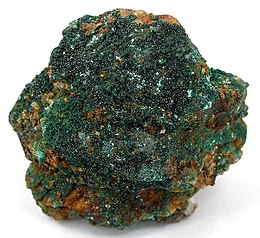| Paratacamite | |
|---|---|
 Paratacamite from Cornwall, England | |
| General | |
| Category | Halide mineral |
| Formula (repeating unit) | Cu3(Cu,Zn)(OH)6Cl2 |
| IMA symbol | Pata[1] |
| Strunz classification | III / D.01-55 |
| Crystal system | Trigonal |
| Crystal class | Rhombohedral |
| Unit cell | a = 13,654, c = 14,041; |
| Identification | |
| Formula mass | 58.433 g/mol |
| Color | Green |
| Cleavage | Very good |
| Fracture | Conchoidal |
| Mohs scale hardness | 3 |
| Luster | Vitreous |
| Streak | Green |
| Diaphaneity | Transparent |
| Specific gravity | 3.74 |
| Density | 3.74g/cm3 |
| Solubility | Acid-soluble |
| References | [2] |
Paratacamite is a mineral in the halide minerals category. Its chemical formula is Cu3(Cu,Zn)(OH)6Cl2. Its name is derived from its association with atacamite. Paratacamite was first described by Herbert Smith in 1906.[3] The zincian endmember Cu3(Zn)(OH)6Cl2 is called herbertsmithite, and paratacamite is polymorphous with botallackite and atacamite.[4]
It has been found in Chile, Botallack Mine in Cornwall, Broken Hill, Australia, and in Italy at Capo Calamita on the island of Elba.[2]
See also
[edit]References
[edit]- ^ Warr, L.N. (2021). "IMA–CNMNC approved mineral symbols". Mineralogical Magazine. 85 (3): 291–320. Bibcode:2021MinM...85..291W. doi:10.1180/mgm.2021.43. S2CID 235729616.
- ^ a b "Paratacamite: Paratacamite mineral information and data". mindat.org. Retrieved 2017-09-20.
- ^ Smith, G.F.H.; Prior, G.T. (1906). "Paratacamite, a new oxychloride of copper". Mineralogical Magazine. 14: 170–177.
- ^ Braithwaite, RSW; Mereiter, K; Paar, WH; Clark, AM (1004). "Herbertsmithite, Cu3Zn(OH)6Cl2, a new species, and the definition of paratacamite" (PDF). Mineralogical Magazine. 68: 527–539. doi:10.1180/0026461046830204.
Wikimedia Commons has media related to Paratacamite.